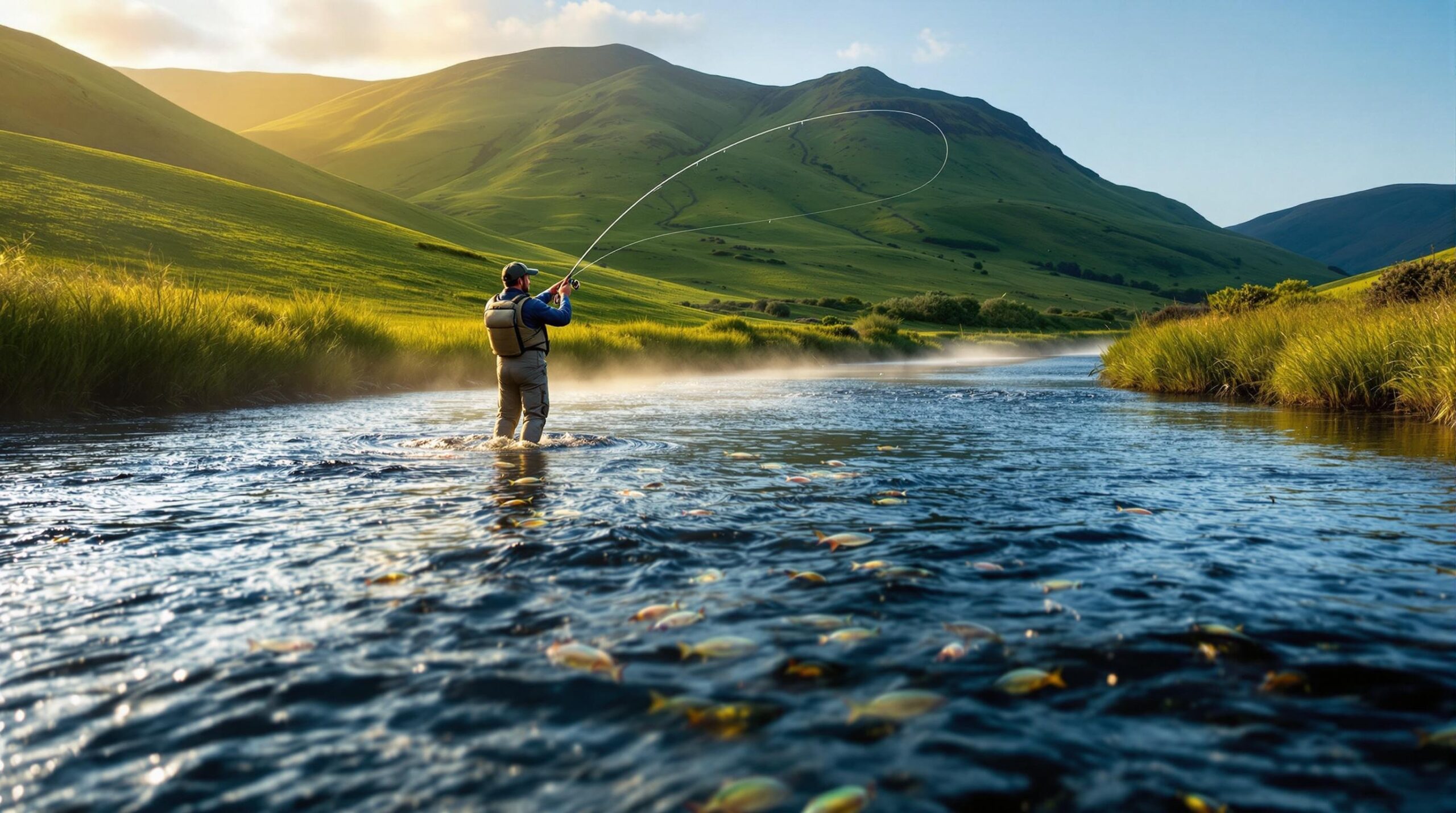According to research by the Economic and Social Research Institute, fly fishing in Ireland attracts more than 150,000 international anglers annually, contributing approximately €1 billion to the country’s economy and supporting 13,000 jobs. With 70,000 kilometers of rivers, 144,000 hectares of lakes, and a 5,600-kilometer coastline, Ireland offers some of the most pristine fly fishing waters in Europe, making fly fishing in Ireland a bucket-list experience for anglers worldwide.
Key Takeaways
- Ireland boasts diverse fishing habitats including 70,000 km of rivers and 144,000 hectares of lakes perfect for fly fishing in Ireland
- The prime fishing season for salmon runs from February to September, with June-July offering peak conditions
- Lough Corrib and Lough Mask are home to the genetically distinct ferox trout that can reach weights exceeding 20 pounds
- Southwest Ireland’s waters like Lough Currane produce trophy trout exceeding 10 pounds
- Sustainable catch-and-release practices have been pioneered for over 30 years to preserve Ireland’s unique fishing ecosystem
Premier Fly Fishing Regions in Ireland
Ireland’s reputation as a fly fishing paradise is well-deserved. The country’s diverse waterways offer exceptional opportunities for targeting Atlantic salmon, wild brown trout, sea trout, and the elusive ferox trout. Each region presents unique characteristics that make fly fishing in Ireland such a remarkable experience.
When planning your Irish fly fishing adventure, consider both the season and target species. According to Inland Fisheries Ireland, salmon fishing peaks during June and July, while brown trout season typically runs from March through September. The country’s western lakes and eastern rivers each offer distinct fly fishing in Ireland experiences that cater to different angling preferences.
The key to a successful fishing trip lies in matching your tactics to the specific waters. From delicate dry fly presentations on gin-clear streams to streamer fishing on vast loughs, versatility is essential when fly fishing in Ireland.
Southwest Ireland’s Essential Fly Fishing Destinations
The southwest region represents some of the most productive waters for fly fishing in Ireland, combining breathtaking scenery with exceptional angling opportunities. This area has become a magnet for international anglers seeking memorable experiences.
Lough Currane – Trophy Trout and Salmon Waters
Spanning 2,500 acres, Lough Currane has earned its reputation as a premier destination for fly fishing in Ireland. The lake consistently produces trophy trout exceeding 10 pounds and offers an extended salmon season running from April through October. Local reports indicate that anglers staying at accommodations like Churchtown House regularly experience exceptional catch rates during peak season.
The economic impact of angling in this region is substantial, with studies showing visitors contribute between €41-58 per trip to the local Waterville economy. The lake’s unique ecosystem supports various fishing techniques, from traditional wet fly approaches to modern nymphing methods.
Dingle Peninsula – Ireland’s Saltwater Fly Fishing Paradise
For those seeking diversity in their fly fishing in Ireland experience, the Dingle Peninsula offers outstanding saltwater opportunities. Anglers can target sea bass, pollock, and mackerel along the rugged coastline. Charter options like Dingle Boat Tours provide access to productive fishing grounds that might otherwise remain inaccessible.
The combination of freshwater and saltwater fishing makes this region particularly attractive for extended fly fishing vacations. The peninsula’s strategic location allows anglers to adapt their plans according to weather conditions while always having productive waters within reach.
Exploring Fly Fishing in Ireland’s Western Lakes
The western lakes represent the heartland of traditional fly fishing in Ireland, with waters that have challenged and rewarded anglers for generations. These extensive lake systems harbor some of Europe’s most distinctive trout populations.
Lough Corrib and Lough Mask – Home of the Mighty Ferox Trout
These two interconnected lake systems create a unique habitat for the genetically distinct ferox trout, which can reach weights exceeding 20 pounds. According to scientific research, 92% of ferox trout spawn in the Cong River, highlighting their concentrated breeding patterns and the importance of conservation efforts.
Local experts like Jackie Mahon provide guided experiences that combine traditional boat drifting techniques with modern approaches to fly fishing in Ireland. The vastness of these lakes requires specialized knowledge of feeding areas and seasonal movements that experienced guides have accumulated over decades.
Lough Arrow and Lough Melvin Fishing Experiences
These smaller but equally productive lakes offer some of the most technical dry fly fishing in Ireland. The lakes are renowned for their specialized brown trout strains and impressive seasonal hatches of mayflies and olives.
For those seeking river fishing, the nearby Owenmore River features 33 named pools that attract salmon anglers from around the world. The combination of lake and river options makes this region particularly versatile for fly fishing in Ireland experiences.
Top Rivers for Fly Fishing in Ireland’s Southeast
The southeast region offers some of the most picturesque stream fishing available in Europe. These rivers typically feature exceptional water clarity and healthy populations of wild brown trout.
River Nire and Suir – Clear Water Trout Fishing
These limestone-influenced rivers produce brown trout averaging 16-18 inches, with specimens regularly exceeding 20 inches. Clonanav Fly Fishing’s catch-and-release programs have reported impressive results, with 36 trout caught and released in just three days during the 2023 season.
The gin-clear waters make these rivers ideal for sight-fishing, allowing anglers to spot and target specific fish. These conditions create perfect opportunities for fly fishing in Ireland with light tackle and delicate presentations that challenge even experienced anglers.
The Snaa at Baronscourt – Exclusive Salmon Waters
For those seeking premium salmon fishing, the Snaa offers 24 meticulously maintained pools across four beats. Luxury accommodations at Belle Isle Estate in Fermanagh provide an excellent base for exploring these waters while enjoying complementary activities like woodcock shooting during non-fishing periods.
These exclusive waters represent some of the most carefully managed fisheries in Ireland, with conservation practices that have maintained healthy salmon populations despite declining numbers in many European rivers.
Planning Your Fly Fishing in Ireland Adventure
Creating a successful fly fishing in Ireland itinerary requires careful consideration of seasons, license requirements, and appropriate gear. With proper planning, anglers can maximize their chances of success on Irish waters.
Essential Fishing Seasons and License Requirements
Understanding the seasonal patterns is crucial for fly fishing in Ireland. The prime seasons generally align as follows:
- Salmon: February-September (peak June-July)
- Brown Trout: March-September
- Sea Bass: May-October
License costs range from €20 for a daily permit to €100 for an annual salmon/sea trout license. According to Inland Fisheries Ireland, all revenue from licenses directly supports conservation efforts and habitat improvement programs.
Recommended Gear for Irish Waters
Equipment selection should match the diverse conditions encountered when fly fishing in Ireland. Recommended setups include:
- Small rivers: 9’9″ #3 weight rod with floating line
- Salmon fishing: 8-9 weight rods with intermediate sinking tips
- Lake fishing: 10′ #5-6 weight rods for greater casting distance
Effective fly patterns for Irish waters include the Klinkhammer for dry-dropper setups, traditional wet flies like the Dabblers for lough-style fishing, and various shrimp patterns for salmon waters. Weather conditions in Ireland can change rapidly, so waterproof gear is essential regardless of the forecast.
Conservation Efforts and Sustainable Fly Fishing in Ireland
Ireland has become a model for sustainable angling practices, with conservation efforts that have preserved the quality of fly fishing in Ireland for future generations.
Catch-and-Release Practices Across Ireland
Operations like Clonanav have pioneered catch-and-release methods for over 30 years, demonstrating the positive impact these practices have on maintaining trophy trout populations. Recent studies have documented significant improvements in both fish size and numbers in waters where these practices have been consistently applied.
Proper fish handling techniques are emphasized throughout Ireland’s angling community, with guides demonstrating best practices for minimizing stress on released fish. These conservation-minded approaches have been instrumental in preserving the quality of fly fishing in Ireland despite increasing angling pressure.
Economic Impact of Fly Fishing in Ireland
The financial contribution of angling tourism is substantial, with domestic anglers spending approximately €633 million annually and international visitors contributing an additional €200 million pre-pandemic. This revenue supports a network of guides, tackle shops, accommodations, and restaurants throughout rural Ireland.
By choosing guided fishing experiences, visiting anglers directly contribute to local economies while gaining access to generations of knowledge about fly fishing in Ireland. This symbiotic relationship benefits both the angling community and the conservation of Ireland’s aquatic resources.
FAQ About Fly Fishing in Ireland
What is the best time of year for fly fishing in Ireland?
The optimal time depends on your target species. For brown trout, the season peaks from April through June during the mayfly hatches. Salmon fishing is most productive from June through August. Sea trout fishing is typically best from June through September. Weather patterns can shift these windows slightly from year to year.
Do I need a fishing license for fly fishing in Ireland?
Yes, licenses are required for salmon and sea trout fishing throughout Ireland. Brown trout fishing on many waters requires permits but not necessarily a government license. Costs range from €20 for daily permits to €100 for annual salmon licenses. Some private fisheries have their own permit systems separate from national licenses.
What are the most effective fly patterns for Irish waters?
Traditional Irish wet flies like the Dabblers, Bibios, and Claret Bumbles work exceptionally well on the loughs. For river fishing, Klinkhammers, F-Flies, and various nymph patterns are productive. Salmon flies vary by water and season, but patterns like the Cascade, Ally’s Shrimp, and various tube flies have proven effective across Ireland.
Is guided fishing recommended for fly fishing in Ireland?
For first-time visitors, guided fishing is highly recommended. Irish waters can be challenging to read, and local knowledge significantly increases success rates. Guides also provide boats for lough fishing, which are essential for accessing the most productive areas. Additionally, guides can help navigate the permit system and identify currently productive waters.
What weight fly rod should I bring for fly fishing in Ireland?
A versatile setup would include a 9’6″ 5-weight rod for general trout fishing, a 10′ 6 or 7-weight for lough fishing, and a 9′ 8 or 9-weight for salmon fishing. If limited to one rod, a 10′ 6-weight offers the most versatility across different Irish fishing scenarios.
Are there opportunities for beginners to enjoy fly fishing in Ireland?
Absolutely. Many guides and fishing lodges offer instruction for beginners, with some waters being particularly suitable for novices. The River Nire, parts of the River Suir, and smaller loughs offer excellent conditions for learning. Several fishing schools also operate throughout the country, offering comprehensive instruction in traditional Irish fly fishing techniques.
Sources:
Yellow Dog Flyfishing – September 2023 Ireland Trip Report
Inland Fisheries Ireland – New Scientific Research on Ferox Trout in Lough Corrib & Lough Mask Highlights the Importance of Conservation of this Valuable Trout Stock
Guideline Fly Fish – A Day of Brown Trout River Fishing in Ireland
Inland Fisheries Ireland – Case Study: Promoting Sustainable Angling
Inland Fisheries Ireland – Promoting Sustainable Angling
ESRI – JA201747


